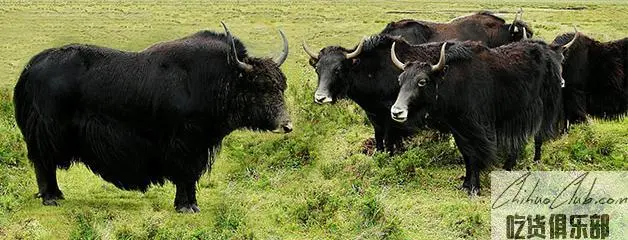
Jiali Yak (Nian Ya Ya Niu)
-
Update date::
-
Date of protection::
-
Protected range:The production area of Jiali Yak (Nianya Yak) is the administrative area of 6 townships in Xiama Township, Caodu Township, Aza Town, Zhabi Township, Lindi Township and Rongduo Township of Jiali County, Tibet Autonomous Region.
-
Category:
Jiali yak (Nianya Yak) is cultivated in the natural Tibetan northern grassland at an altitude of over 4,500 meters. It is tall, has many hairs, and is rich in flesh. It is rich in various minerals (calcium, selenium, copper, etc.), amino acids, protein, and nutrition. High value.
The hair of the Jiali yak is mostly dark brown, some are spotted, and a few are gray and camel. The bull's head is large and heavy, the angle base is thick, the angle is outwardly folded upward, the corner tip is backward, the neck is thick and strong, and there is no flesh; the armor is high and the peak is raised, the male features are obvious, the back waist is flat until the cross, and the body is tall. The body is firm, compact, and the chest is open; the hindquarters are poorly developed, the limbs are short and stout; the testicles are small, the constriction is suspended in the posterior abdomen, and does not sag; the lower part of the body is dense and coarse, the body is covered with fluff and Two types of hair, the group hair is long and the tail hair is long and fluffy. Most of the cows have horns, the angles are outward and upward, the head is long and delicate, the lips are thin and flexible, the back waist is straight to the cross, the abdomen is compact and not drooping, the breast is compact and semi-circular, and the nipple is short. Jiali yak is mainly distributed in Xujia, Cuba, Wushen Road and other surrounding areas in Jiali County, Nagqu, Tibet, which is 91°09′01′′ east longitude, 31°07′32′′ north latitude, and the altitude of the distribution area is 3700m. ~ 4400m, can be grazing to 5000m in warm season, is a sub-humid monsoon climate zone in the plateau sub-frigid zone, the annual temperature difference is large, the average annual temperature is -0.9 °C, the annual precipitation is 695.5mm, the annual evaporation is 664.5 mm, the annual sunshine hours 2405.2h, no absolute frost-free period throughout the year, frequent snowfall in winter; the main grazing grassland is alpine meadow, alpine meadow grassland, alpine meadow and so on. Artificially grown forages mainly include shawl, barley, peas and the like.
Jiali yak (Nianya yak) quality technical requirements First, the source of Tibetan alpine yak. Second, the breeding environment is above 4,300 meters above sea level, alpine meadow vegetation. The source of the water is the source of the Maidi Zangbo River (upstream of the Lhasa River), lakes and alpine snow. Third, feeding management 1. Ranch environment: natural pasture. 2. Feeding methods: grazing. 3. Feed conditions: The natural grass is mainly forage, supplemented with appropriate amount of succulent feed and concentrate. 4. Feeding management points: (1) Yak management: Spring calving should be antifreeze, yak weaning at the age of 6 and feeding with cows; after weaning, feed dry green, silage, succulent feed and concentrate. (2) Warm season fattening: natural grassland grazing and fattening, supplemented with salt and other mineral nutrients. 5. Arrival: 3.5 to 5.5 years old, cows live 180 to 220 kg, and calves live 250 to 300 kg. 6. Environmental and safety requirements: Feeding environment, prevention and control of epidemic diseases must implement relevant national regulations and must not pollute the environment. 4. Slaughtering and Processing 1. Source of yak: Healthy yak from the area of origin that meets the above criteria. 2. Resting to be slaughtered: The yak to be slaughtered should stop eating for 24 hours before slaughter and stop drinking for 3 hours before slaughter. 3. Slaughtering method: Use the rope to tie the yak mouth and nose, and let it suffocate and die. 4. Carbohydrate acid removal: acid release at 0 to 4 ° C, relative humidity of 85% to 90% of environmental conditions for 48h. V. Quality characteristics 1. Sensory index: The meat is firm, the color is bright red, the cut surface is marbled, the connective tissue is white, the fat is light yellow or dark yellow, the meat is elastic and the meat is delicious. 2. Physical and chemical indicators: protein content ≥ 20%, fat content ≤ 3.7%. 3. Safety and other quality technical requirements: Product safety and other quality technical requirements must comply with relevant national regulations.
Apply to:
Producers within the scope of production of Jiali Yak (Nian Ya Ya Niu) may apply to the Quality and Technical Supervision Bureau of Nagqu District of Tibet Autonomous Region for the use of “Special Marks for Geographical Indication Products”, which are reviewed by the Quality and Technical Supervision Bureau of Tibet Autonomous Region and reported to the General Administration of Quality Supervision and Inspection. Announced after approval. The testing organization of Jiali Yak (Nianya Yak) is selected by the Tibet Autonomous Region Quality and Technical Supervision Bureau in the testing institutions that meet the qualification requirements.